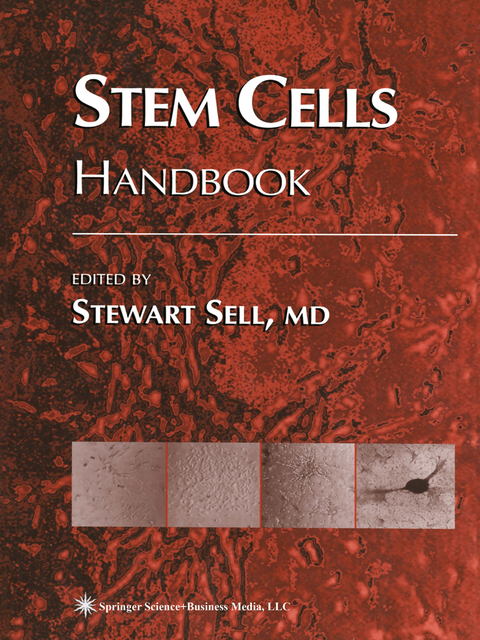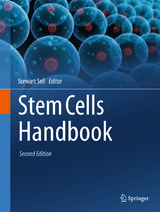
Stem Cells Handbook
Humana Press Inc. (Verlag)
978-1-61737-367-1 (ISBN)
- Titel erscheint in neuer Auflage
- Artikel merken
1 Stem Cells: What Are They? Where Do They Come From? Why Are They Here? When Do They Go Wrong? Where Are They Going?.- 2 Stem Cells from Early Mammalian Embryos: Common Themes and Significant Differences.- 3 Embryonic Stem Cells: Isolation and Application of Pluripotent Cells from the Pregastrulation Mammalian Embryo.- 4 From Stem Cells to Functional Tissue Architecture: What Are the Signals and How Are They Processed?.- 5 Germline Stem Cells.- 6 Stem Cells and Cloning.- 7 Genomic Imprinting in Mouse Embryonic Stem and Germ Cells.- 8 Stem Cells in Amphibian Regeneration.- 9 Stem Cells in Dermal Wound Healing.- 10 Bone Marrow Mesenchymal Stem Cells.- 11 Normal and Leukemic Hematopoietic Stem Cells and Lineages.- 12 Developmental Origin of Murine Hematopoietic Stem Cells.- 13 Stromal Support of Hematopoiesis.- 14 Hematopoietic Stem Cells: Identification, Characterization, and Assays.- 15 Hematopoietic Stem Cells in Leukemia and Lymphoma.- 16 Neurons, Stem Cells, and Potential Therapies.- 17 Neural Stem Cells: From In Vivo to In Vitro and Back Again—Practical Aspects.- 18 Molecular Genetic Approaches in the Study of Retinal Progenitor Cells and Stem Cells.- 19 Endothelial Progenitor Cells.- 20 Development of the Cardiovascular System in Embryoid Bodies Derived from Embryonic Stem Cells.- 21 Transcription Factors, Growth Factors, and Signal Cascades Capable of Priming Cardiogenesis.- 22 Strategies Using Cell Therapy to Induce Cardiomyocyte Regeneration in Adults with Heart Disease.- 23 Generation and Stem Cell Repair of Cardiac Tissues.- 24 Stem Cells in Kidney Morphogenesis.- 25 Nephroblastoma: A Metanephric Caricature.- 26 Stem Cells in Nonmelanoma Skin Cancer.- 27 The Stem Cell Plasticity of Aggressive Melanoma Tumor Cells.- 28 Stem Cells in Glandular Organs.- 29Gastrointestinal Stem Cells: Proliferation Kinetics and Differentiation Hierarchies.- 30 Stem Cell Origin of Cell Lineages, Proliferative Units, and Cancer in the Gastrointestinal Tract.- 31 Specification of Liver from Embryonic Endoderm.- 32 Animal Models for Assessing the Contribution of Stem Cells to Liver Development.- 33 Normal Liver Progenitor Cells in Culture.- 34 Permanent Lines of Stem Cells from the Liver.- 35 Biology of Human Liver Stem Cells.- 36 Transplantation of Hepatic Stem Cells and Potential Applications for Cell Therapy.- 37 Plasticity of Adult-Derived Pancreatic Stem Cells.- 38 Islet Cells.- 39 Mammary Epithelial Stem Cells.- 40 Morphogenesis of Prostate Cancer.- 41 Stem Cells in Lung Morphogenesis, Regeneration, and Carcinogenesis.- 42 Noninvasive Imaging in Stem Cell Therapies: Current State and Future Perspectives.- 43 What Is the Future for Stem Cell Research?: Whether Entity or Function?.
"Truly outstanding descriptions of the fields of early mammalian development, DNA methylation, neural stem cell biology, and imaging technologies help round the reader's knowledge through the use of perspicuous language and concepts." - Developmental Cell
| Erscheint lt. Verlag | 9.12.2010 |
|---|---|
| Zusatzinfo | 22 Illustrations, color; 229 Illustrations, black and white; XIII, 509 p. 251 illus., 22 illus. in color. |
| Verlagsort | Totowa, NJ |
| Sprache | englisch |
| Maße | 210 x 279 mm |
| Themenwelt | Medizin / Pharmazie ► Medizinische Fachgebiete |
| Studium ► 2. Studienabschnitt (Klinik) ► Humangenetik | |
| ISBN-10 | 1-61737-367-2 / 1617373672 |
| ISBN-13 | 978-1-61737-367-1 / 9781617373671 |
| Zustand | Neuware |
| Haben Sie eine Frage zum Produkt? |
aus dem Bereich



